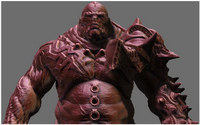Next-Gen 3D Rendering Technology: Voxel Ray Casting
Conclusion
Real-time 3D rendering is in a particularly exciting phase of its evolution. With the arrival of GPUs that are more and more programmable, a lot of approaches that have been out of the question up until now are reappearing, as developers try to solve the problems at hand.
Voxel octree ray casting is an especially promising technique for drastically increasing the geometric complexity of the games of the future. Obviously, it’s all still in the experimental stage, and Olick's demonstration at SIGGRAPH is more of a feasibility demonstration than anything else. A lot of questions remain unanswered.
One of those questions, which will be decisive for the future of the technology, has to do with the editing tools with which graphic artists will have to work. Olick says he expects an evolution of the system currently used for MegaTextures, which lets artists apply buffers to add details to a texture. Such a system, instead of modifying the normal map, would directly modify the geometry with this technology. But for now, everything is still in the conceptual stage and as we know, making nice demos is far from being the hardest part. They then have to be turned into a finished product that’s sufficiently stable and efficient.
Still, it’s very interesting to see a model animated using several million polygons (seven million in the initial model, done with ZBrush) at 60 frames per second on a present-generation card. These early results are extremely promising when you think about the hardware that will be available by the time games that actually use the technology hit the market. Given the development times for games nowadays, and considering how id Software doesn’t plan to release Rage before next year, we’d probably have to wait three or four years before this type of rendering hits retail shelves.
Get Tom's Hardware's best news and in-depth reviews, straight to your inbox.
-
doomtomb This stuff is pretty interesting but a little over my head. The only thing I really care about is when we will start seeing this in our games.Reply -
the_krasno This is awesome, the people that can really gain something here are amateur filmmakers that can't afford the giant rendering farms big studios have! :)Reply -
the_krasno the_krasnoThis is awesome, the people that can really gain something here are amateur filmmakers that can't afford the giant rendering farms big studios have!I meant independent, not amateur. Sorry.Reply -
personally i like raytracing, except for the performance issues. if you've ever tried doing a little 3d rendering, ray tracing is very good, makes things look very real if done properly. again i know it is slowReply
-
liquidsnake718 Very interesting stuff, I do understand how limiting cubes or voxels can be limited in terms of depth and height(same height per distance) as polygons have that advantage where the triangle gives us just that, an angle that can be measured in terms of height and distanve. We have a vanishing point with a triangle as well.....Reply
Iwonder if they can impliment both polygons and advanced cubes with different sizes for the initial layers creating a more fluid and complexed scenario or landscape........ -
JonathanDeane Interesting but voxels will have some extreme performance and space constraint hurdles to overcome before they become the main rendering of any game. I just downloaded a small demo http://www.advsys.net/ken/voxlap/voxlap03.htm its a little over 500K for the whole works but after you hit the genall batch file (it speeds up loading) the thing occupies about 120MB's of space for this simple game. Something like Quake 3 would have been a multi DVD file...Reply
